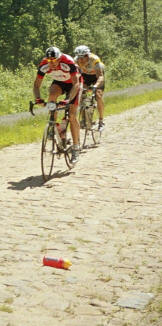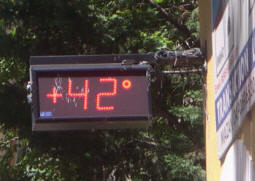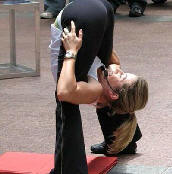Muscle Cramps

Me with an attack of camp...
Giro Lombardia Fondo ~ Ghisallo Descent
I'll be honest with you and let you know up front that I really feel like one of the lucky ones. I've never had cramp on the bike; I've looked a bit camp once or twice (as you can see above) but I've never actually had cramp itself.
So this factsheet is written from my own research, anecdotal evidence and listening to my mates' remedies and opinions. It doesn't mean it's any less factual or relevant, it just means that I can't draw on my own experiences to shed any light on this mysterious, enigmatic and highly painful affliction.
What
is it?
A muscle cramp is basically an involuntary muscle spasm of
perceived biblical proportions. Which means the muscle (of it's own
accord) contracts with such a force that it hurts a lot more than you
would like it to. Very few people complain of mild-cramps. It's either a full on spasm or it's not.
You know when you've got
it.
 How is it caused?
How is it caused?
There are many perceived causes of cramp but few can yet agree on the
trigger point that causes the agonising muscle seizure that can debilitate
the most powerful of athletes.
When it comes, it comes with a vengeance. Tell-tale warning signs are sometimes given but often overlooked in the heat of battle. The little twinge just as you get out of the saddle or begin to apply maximum power can often be ignored in the maelstrom of competition. Seconds later; it's game over! Excruciating pain, a cliff-like power drop off and instant reverse gear are the norm.
Can I
prevent it?
If we don't know what causes cramp then how can we hope to prevent it?
Difficult to answer this question but once again common sense and
anecdotal evidence come in to play.
Some contributing factors to the onset of muscle cramps are believed to be found amongst the following:
▼ Dehydration
▼ Mineral deficiency
▼ Temperature changes
▼ Blood flow and circulation
▼ Tightness and inflexibility
▼ Ergonomics
▼ Cold or unprepared muscles
▼ Lying in bed!
Dehydration
 Seems
an obvious one but, in my opinion, it isn't necessarily the top factor.
I've had, and seen many people, with big dehydration problems in a few of
the sportives I've done, specifically the Ariegoise and Paris Roubaix.
Seems
an obvious one but, in my opinion, it isn't necessarily the top factor.
I've had, and seen many people, with big dehydration problems in a few of
the sportives I've done, specifically the Ariegoise and Paris Roubaix.
Dave Whitt, Steve Goaziou and myself all ran out of water at various points of the Roubaix but none of us suffered any signs of cramp while powering across the baking cobbles of northern France.
So I believe dehydration can be a contributing factor towards cramp when other contributing factors are also present.
Being de-hydrated may not bring on cramp as such but it will seriously affect your performance levels. So ensure you're well hydrated before exercise and keep topped up throughout your event.
Mineral
Deficiency
When you sweat you don't just lose fluids you
lose minerals. And this could be where the dehydration theory comes
from. It's
a little bit cause and effect. I've got cramp and I'm thirsty; so
thirst causes cramp!
It was believed that cramp was brought on by deficiencies of potassium, magnesium and calcium, although further research has shed doubt on this. These minerals are easily replaced and are in abundance in the body.
Milk on the breakfast and a banana mid ride can easily bring these minerals back up to "safe" levels. However, sweating, which is the main cause of dehydration, creates higher imbalances of sodium and chloride within the body than those of potassium etc.

Sodium is one of the initiators of nerve activity that leads to muscle movements. An imbalance here is thought to cause misfiring muscle actions. When physiological things get out of synch, your body tries to restore the balance. It can either build up potassium levels or stop doing what it's being asked to do. Guess which is the quick-fix option?
At some big foreign sportives you'll find bananas, apricots, figs, salted nuts and savoury meats lined up next to the jam cakes and sports drinks and cola. They're there for a reason! It may be an anecdotal reason, but it's a reason none the less. Don't be afraid to experiment with your food intake; but not on a targeted race day!
Loads of riders still swear by the good old banana. I eat at least one a ride and have always eaten one daily as part of my 5-a-day routine. And I don't get cramp. Anecdotal and flimsy evidence if ever there was. I don't intend to stop eating them just to find out if I get cramp.
A good diet, a good sports drink and a good hydration strategy may help you stay cramp free. And don't go throwing tons of salt on your food. If you have a big event coming up and you think you might be pre-disposed to cramp, try building up your sodium levels for the three days prior to the event with a little extra on your evening meal. Too much sodium is worse than too little. Everything in moderation
Temperature Changes
 Tricky one this.
I've climbed the Galibier with the boys in temperatures
of well over 30 degrees at the bottom and around six at the
top.
Tricky one this.
I've climbed the Galibier with the boys in temperatures
of well over 30 degrees at the bottom and around six at the
top.
Ice at the summit and melted tarmac at the base. But we didn't get cramp.
I've also climbed Ventoux when it was in the 40's, and survived.
However, if you're disposed to it this may be a contributing factor. Keep muscles warm and always carry a gilet in the mountains.
Blood
Flow & Circulation
 I know a few people with blood circulatory problem due to furred up
arteries in their legs. This causes a lack of oxygen to the muscles
and gives them cramps in their calf.
I know a few people with blood circulatory problem due to furred up
arteries in their legs. This causes a lack of oxygen to the muscles
and gives them cramps in their calf.
One has had an op to increase the blood flow the others still suffer.
Some riders have indicated they are more likely to get onset of cramp when they wear shorts that are tight around the thigh.
Others, when their shoes are too tight feel their toes cramping up.
Again, these things may not be the actual causes of cramp itself. But when combined with other possible contributing factors they may all add up to create the perfect storm.
Tightness & Inflexibility
 The
fitter you get the more honed your body becomes and the more taught your
muscles become. This can be counteracted by stretching and core
stability exercises that restore the balance that nature intended.
The
fitter you get the more honed your body becomes and the more taught your
muscles become. This can be counteracted by stretching and core
stability exercises that restore the balance that nature intended.
Now I'm not saying that flexible people never get cramp but it's just one more thing that could help. Unless you're like the very talented young lady on the right, we could all probably be a little more flexible. In mind as well as body!
Ergonomics
Changed anything on your bike recently? Or maybe you've just moved
from your training bike to your race bike. Everything you change
from the norm has a consequence. So make sure you have a very good
reason for changing it. And never make a change prior to a key
competition. If it's not right, leave it until you can give your
body time to adapt and compensate for the changes.
Over time your body adapts to the effort and motions you impose on it. It's suggested the muscles, nerves and joints take on a memory of the loads and range of movements they are required to undertake. Move outside these range of movements, even by a fraction, and some bodies are predisposed to rebel. The rebellion often takes the form of cramp.
Swapping shoes, cleats, saddle position, handle bars or stems etc. can all have an effect on how your body reacts to the change. Some bodies get on with it and learn the new firing patterns with little disruption. Younger bodies and flexible older bodies, may be more forgiving than most. If you do have to change anything do it in fractions over a period of time. Don't tempt fate.
Cold or unprepared muscles
As you all know, if you've been round for a
sports test, we have a dog;
Meg. Daft as a brush, sleeps sixteen hours a day but
when she moves she moves like lightening. That's her in action below.

She can go from fast asleep to full gas in the time it takes to say, "Where's the pussy cat!" No warming up, no stretching, no pre-effort routine. I've yet to witness any hint of cramp in her.
Now I don't expect the same for us. However, I've seen people sitting on the cold damp grass for 40 minutes while they watch a crit at Les Quennevais. As the first race finishes, they get up, ride a lap to the start (it can hardly be called a warm up) then knock out a 30 mph first lap to try and drop people. Not seen any cramp there either. So again, no conclusive evidence.
It's recognised best practice to warm up, get the muscles ready to fire and ease in to the event. I'm still not convinced that stretching prior to exercise is a good thing but I would highly recommend it for afterwards. Prepare yourself for action with a decent warm up and keep your muscles warm for as long as you can. It can't do any harm can it?
The Message
As you can see we've not really proved anything so far.
We've listed
a lot of things that could contribute to cramp, in a pre-disposed
individual, but proved nothing.
I have a theory that each one of the factors listed above, individually contributes 5% towards the chance of getting cramp. However, each additional factor gives an exponential probability rise.

So, suppose you're dehydrated; that's your first individual 5% hit. If you're mineral levels are also low, individually that's another 5%.
However, as it's a second additional factor (along with dehydration) it's compounded to 10% so we now have a 15% chance of getting hit.
If it's cold and damp weather (that's another 5% individually). We now have a 3rd factor and that's worth 15%, to give a 30% chance of suffering cramp.
Throw in a full gas effort (4th factor and 20%) on the big climb (5th factor and 25%) and we're now up to a 75% possibility of getting cramp. For those predisposed to cramp attacks, it's now a matter of when, not if!
The more contributing factors to which we expose ourselves, the more the risk rises exponentially. Your personal cramp threshold index will be somewhere between 5% and 100%. When you exceed your threshold through a combination of any of the know factors, you're hit!
So, obviously (in my opinion remember) it's best to limit your exposure to the risks above by:
▼ Gently topping up your sodium levels
before a big event
▼ Drinking electrolytes during your event
(whether it's hot or cold)
▼ Regularly eating bananas before and during
your event
▼ Carrying a gilet over mountain passes to
keep core temperature up
▼ Ensuring clothing and shoes are snug, not
tight
▼ Working on increasing your flexibility
(especially vets)
▼ Ensuring all your bikes are setup
identically
▼ Having a structured warm up routine for
all events
▼ Being careful (muscle wise) when you go to bed!
Because why so many people get cramp in their calves when in bed is still baffling the white coat wearers. Beware, that big stretch just before you go to sleep at night. The neighbours might get the wrong idea if they hear stifled screams coming from the open bedroom windows. Especially if you live alone!
I hope you have an enjoyable and cramp free weekend.








